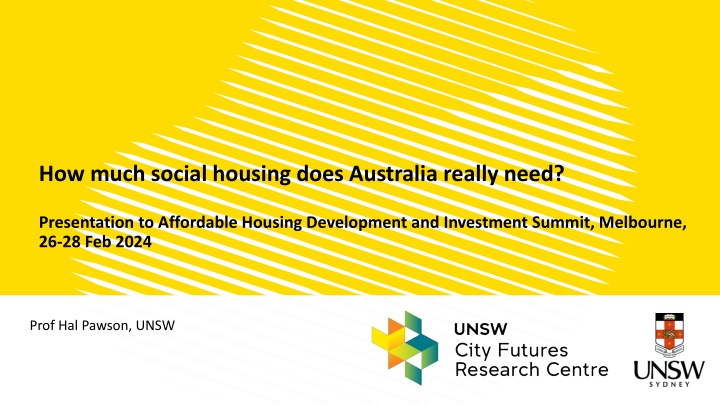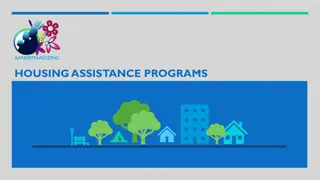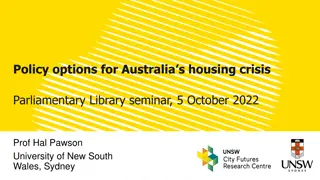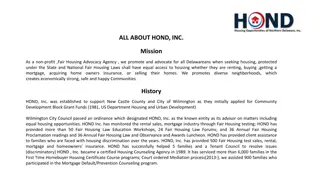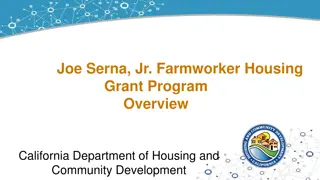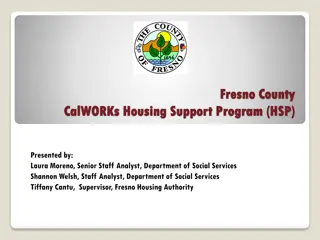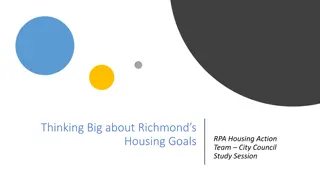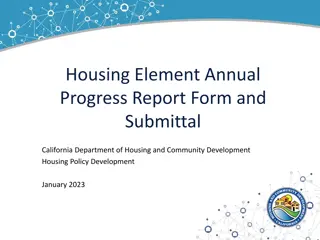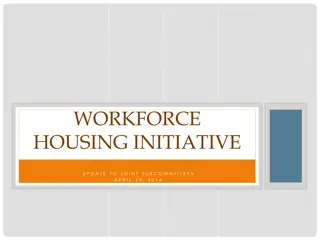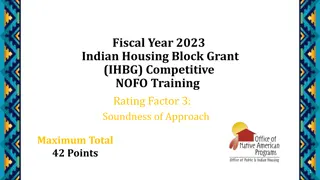Addressing Australia's Social Housing Needs: Insights from Prof. Hal Pawson
Prof. Hal Pawson's presentation at the Affordable Housing Development and Investment Summit in Melbourne delves into the necessity of social housing in Australia. The presentation covers the existing social housing landscape, the projected needs, and the comparison of construction numbers with the scale of demand. It explores the significance of social housing for very low-income households and the limitations of relying solely on private rental tenancies. The discussion highlights the insecurity associated with private rentals and the long-term housing challenges faced by low-income families.
Download Presentation

Please find below an Image/Link to download the presentation.
The content on the website is provided AS IS for your information and personal use only. It may not be sold, licensed, or shared on other websites without obtaining consent from the author.If you encounter any issues during the download, it is possible that the publisher has removed the file from their server.
You are allowed to download the files provided on this website for personal or commercial use, subject to the condition that they are used lawfully. All files are the property of their respective owners.
The content on the website is provided AS IS for your information and personal use only. It may not be sold, licensed, or shared on other websites without obtaining consent from the author.
E N D
Presentation Transcript
How much social housing does Australia really need? Presentation to Affordable Housing Development and Investment Summit, Melbourne, 26-28 Feb 2024 Prof Hal Pawson, UNSW
Presentation overview 1. Why do we need any social housing? 2. How much social housing do we already have? 3. How much social housing do we need? 4. How do projected SH construction numbers tally with scale of need? 5. Concluding points
What is social housing? Social housing sub-market rental homes targeted at very low- income households SH access restricted by state/territory govt income limits; rent usually set at 25% of hhld income; most recipients on social security payments (in Aus) In Aus, SH usually provided as: - Public housing homes owned and managed by state/territory govts or - Community housing homes managed (and sometimes owned) by non-profit providers ( CHPs ) Some CHPs also provide affordable rental housing sub-market homes targeted at low-income workers
Why do we need any social housing? (1) Q. Couldn t we just help everyone in housing need by giving them enough money to find a private rental tenancy? Aus moving down that path since the 1990s growing % of v low-income hhlds in PRS, often supported by CRA One big PRS disadvantage: even if income subsidy makes tenancy affordable , private rental inherently much less secure than social housing PRS still insecure, even if all state/territory govts restricted scope for tenancy terminations outlawing no grounds evictions Housing insecurity fundamentally unsuitable and damaging for families and vulnerable people
Why do we need any social housing? (2) Not every low income hhld in housing need at a point in time has an ongoing housing problem Q. If need is 'temporary isn t it more logical to help via temporary income support? Argument valid but Productivity Commission analysis shows: - Substantial % of hhlds in rental stress at a point in time remain in stress several years later, and - % of stressed renters with ongoing problem increased over time, comparing 2000s to 2010s Private tenants in rental stress: progressive change over 5-year period % of cohort members remaining in 110 rental stress each year 100 2001 cohort 2013 cohort 90 80 70 60 50 40 30 20 10 0 Year 1 Year 2 Year 3 Year 4 Year 5 Source: Productivity Commission (2019)
Why do we need any social housing? (3) Strong quant. evidence that SH generates quantifiable social and financial benefits offsetting cost of provision - Huge perperson costs to govt generated by chronic rough sleeping exceeds unit cost of providing supportive social housing Prof Cameron Parsell, UQ - Broader CBA demonstrates growing cost to govt arising from SH shortfall rising to >$1billion p.a. by mid-2030s Prof Andi Nygaard, Swinburne Univ - Compelling statistical evidence that PH tenancies reduce ex-offender recidivism compared with private rental assistance Dr Chris Martin, UNSW Return on social housing investment comparable to, or better than major infrastructure projects SGS Economics and Planning
How much social housing do we already have? Approx 440,000 SH dwellings 2023 still mainly PH (not CH), despite CH growth trend over past 10-15 years Little built since 1990s when routine annual program ceased Because failing to keep pace with overall population growth, SH down from 6% to 4% of all housing (1996-2021) Australia s SH provision in lower rank of OECD countries average: 7.1% Govt-built housing 16% of all housing construction 1945-70; during 2010s usually around 3,000 units p.a. or 1-2% Australia: Social housing stock, 2023 (000s) 30 108 298 Public housing Community housing Indigenous housing Source: Productivity Commission Report on Govt Services 2024 Table 18A.3
Social housing as % of all (occupied) dwellings, OECD countries, 2020 Source: OECD Netherlands 34.1 Austria 23.6 Denmark 21.4 UK 16.7 France 14.0 Ireland 12.7 Iceland 11.1 Finland 10.0 Korea 8.9 Switzerland 8.0 Poland 7.6 Malta 5.5 Slovenia 4.7 Australia 4.4 Norway 4.3 Belgium 4.2 NZ 3.8 USA 3.6 Canada 3.5 Japan 3.2 Germany 2.7 Hungary 2.6 Italy 2.4 Portugal 2.0 Latvia 1.9 Slovakia 1.6 Luxembourg 1.6 Spain 1.1 Estonia 1.1 Lithuania 0.8 Czechia 0.4 Colombia 0.0 0 5 10 15 20 25 30 35
How much social housing do we actually need? (1) SH waiting list registrations 169,000 households, June 2023 Conceptually simple no. but poor guide to scale of unmet need or changing scale of need from year to year E.g. long-term freeze of income limits ratchets up real eligibility threshold, excluding growing numbers; many eligible hhlds do not apply Census-based estimate by Dr Ryan van den Nouwelant (UNSW) now widely cited Factors in (a) currently homeless people, (b) hhlds in income quintile 1 and in private rental stress Suggests 437,000 hhlds with unmet need for social housing 2021 NHFIC/Housing Australia version of same estimation approach suggests 378,000
How much social housing do we actually need? (2) On the UNSW/NHFIC figures, ostensibly a case for near-doubling current SH stock Fair to note that a % of those affected might be appropriately helped by rent subsidy payments (increased CRA) But, to resolve their situation, a secure and affordable SH tenancy will be needed by most Assistance via enhanced CRA probably viable for larger % of income quintile 2 hhlds with unmet need for affordable rental housing Measures of unmet housing need, Australia, early 2020s (000s) SH waiting list (excl. transfers) 169 Unmet need for social hsg 437 Unmet need for social and affordable rental hsg 640 0 200 400 600 800 Sources: Productivity Commission ROGS 2024; Van den Nouwelant et al. 2022
How do projected SH construction numbers tally with scale of need? (1) What size of SH construction program would we need to address full scale of unmet need e.g. over 20 years? Addressing this question also requires factoring in newly arising need (due to pop growth) in future UNSW estimate: 203,000 hhlds to 2041 Resolving entire need backlog + newly arising need over 20 years via additional SH, would call for net completions averaging 34,000 (approx. 19% of current total housebuilding) Note also: - CFMEU/Oxford Economics costed proposal for a social housing program of around 50,000 units p.a. funded by a super-profits tax for larger companies - Non-profit housing associations now account for 25-30% of UK total housebuilding
How do projected SH construction numbers tally with scale of need? (2) Even to match pop growth (stabilising SH at 4%) demands approx. 10,000 units p.a. (allowing for some associated PH losses to clear sites) HAFF commitment: 20,000 SH dwellings funded in first five years i.e. 4,000 p.a. Some state/territory govts (esp Vic, Qld) significantly complementing federally- funded program from own resources State/territory SH pipeline figures provided to Commonwealth (linked with Social Housing Accelerator program) but many ambiguities because (a) lack of clear SH/ARH split and (b) unclear whether stock additions gross or net Commonwealth should require better quality stats, but bigger point is that state/territory govts lack the financial firepower to extend recent programs
Concluding points (1) Important to note that current HAFF stake ($10 billion) will be exhausted (until 2050) by initial 5-year program Only by supplementing HAFF capital stake can govt generate additional returns needed to fund new development commitments beyond initial tranche (20,000 SH + 10,000 ARH) Measuring unmet housing need not an exact science, but diverse estimates point towards case for social (perhaps incl. affordable rental) housing 8-10% of all housing in Aus But even allowing for some significant state-funded contributions over the next couple of years, committed SH pipeline is small compared with the scale of shortage Unlikely to be sufficient even to temporarily stabilise SH as a % of all housing
Concluding points (2) Australian govts need to think bigger in this area; need to treat social housing as infrastructure investment That is: investment that creates a valuable asset and generates measurable payoffs Also need to acknowledge that Aus effectively spends huge and growing sums on landlord tax concessions (approx. $12 billion p.a.) that could be more equitably and efficiently targeted At a bare minimum, National Housing and Homelessness Plan should commit to enabling, long-term, SH construction sufficient to maintain current share of all housing
References OECD (2023) Social rental dwellings stock https://www.oecd.org/els/family/PH4-2-Social-rental-housing-stock.pdf Productivity Commission (2019) Vulnerable private renters: Evidence and options https://www.pc.gov.au/research/completed/renters Productivity Commission (2024) Report on Government Services 2024 https://www.pc.gov.au/ongoing/report-on-government- services/2024/housing-and-homelessness Van den Nouwelant, R. et al. (2023) National snapshot: Quantifying Australia s unmet housing need https://cityfutures.ada.unsw.edu.au/documents/699/CHIA-housing-need- national-snapshot-v1.0.pdf
